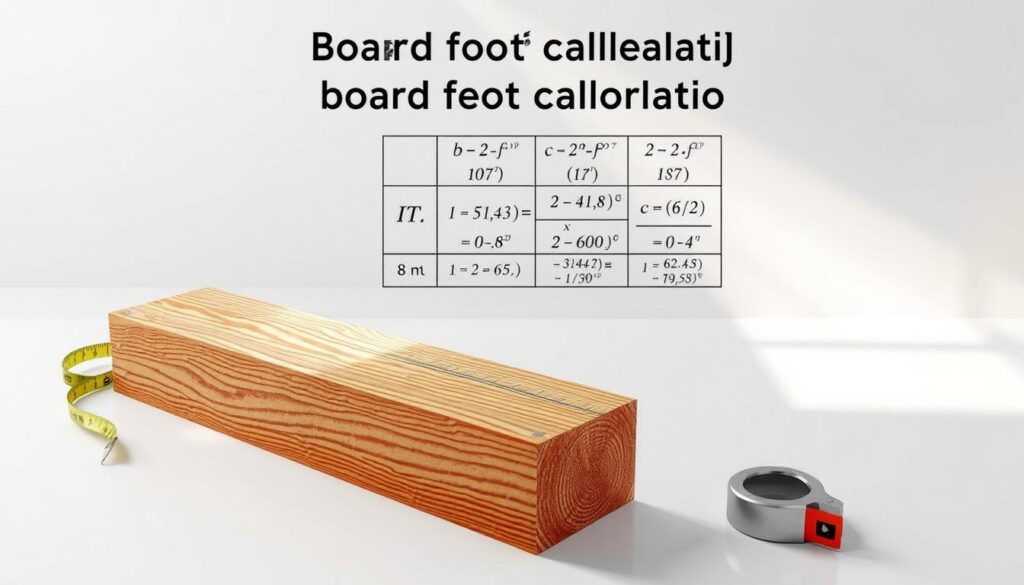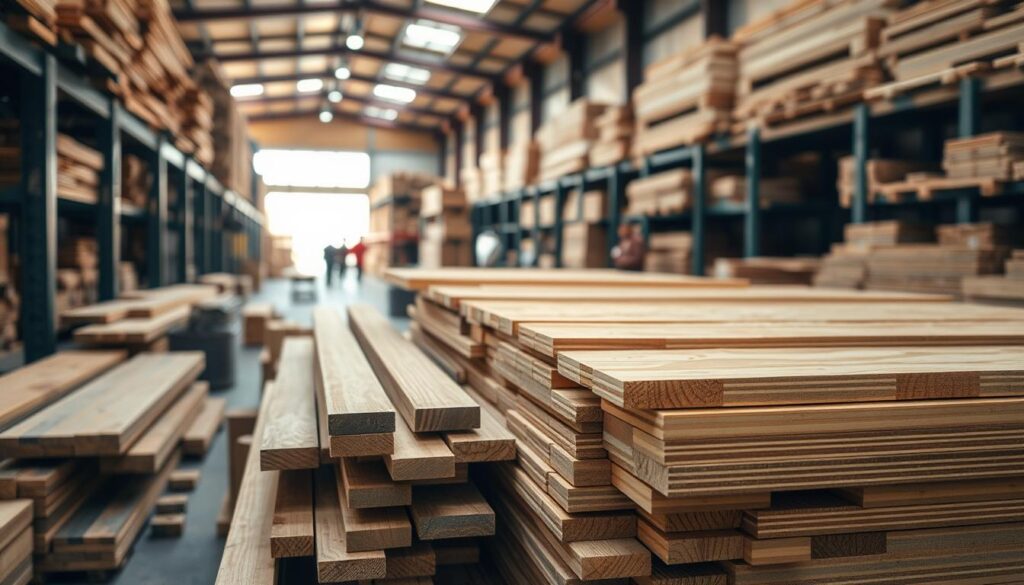Did you know one board foot of lumber is 144 cubic inches? This fact can greatly affect your woodworking project’s efficiency and cost. When I started woodworking, I learned how critical accurate measurements are. They save time, money, and prevent frustration.
In this article, I’ll show you how to use a board foot calculator. It’s a key tool for woodworking and buying lumber. Let’s explore what a board foot is and how to use a lumber board foot calculator.
Whether you’re experienced or new to woodworking, knowing how to measure lumber is vital. It ensures your projects succeed. Let’s dive in!
Understanding Board Feet and Their Importance
Woodworking relies heavily on understanding board feet. A board foot is a way to measure lumber. It’s 1 foot long, 1 foot wide, and 1 inch thick. This means one board foot is 144 cubic inches of wood.
This measurement is key for calculating lumber’s size and price. It helps ensure accuracy in woodworking projects.
What is a Board Foot?
In woodworking, a board foot is a standard unit. It helps avoid confusion when talking about lumber. To figure out a board foot, you multiply the board’s thickness, width, and length.
This makes it easier to know how much lumber you need for projects.
Why Is Accurate Measurement Essential for Woodworking?
Accurate measurements are vital in woodworking. They help manage resources well, reducing waste and improving cost estimates. By measuring correctly, you avoid buying too much or too little material.
The Basics of the Board Foot Calculator
A board foot calculator makes measuring wood easy. You just input the dimensions of your lumber. This tool helps you calculate the board foot volume accurately and quickly. Knowing the board foot formula is key for anyone working with wood, as it shows the wood’s volume based on its size.
How Does a Board Foot Calculator Work?
Using a board foot calculator is simple. Just enter the lumber’s measurements, and the calculator does the math for you. This saves time and reduces the chance of mistakes. Many calculators have a user-friendly interface, making it easy to adjust and recalculate as needed.
Types of Board Foot Calculators Available
There are many types of board foot calculators to fit your needs. You can find:
- Web-based calculators that you can access from any browser, making it convenient.
- Mobile apps for on-the-go use, great for busy projects or when you’re on-site.
- Desktop applications for more detailed analysis and project management features.
Choosing the right board foot calculator can boost your productivity and help with better project planning.
How to Calculate Board Feet Manually
Learning to calculate board feet manually helps me get precise measurements for my woodworking. The board foot formula is key in this process. It defines one board foot as a 12x12x1 inch piece of wood. Using the formula, width x thickness x length (in feet) divided by 12, I can accurately measure lumber size.
Understanding the Board Foot Formula
The board foot formula is vital for anyone who wants to calculate board feet. Knowing the width, thickness, and length of lumber lets me calculate board feet for any project. This formula makes it easy to measure both small and large projects.
Step-by-Step Manual Calculation Process
To calculate board feet manually, I follow these steps:
- Measure the width of the lumber in inches.
- Measure the thickness of the lumber in inches.
- Measure the length of the lumber in feet.
- Use the board foot formula: multiply the width by the thickness, then multiply the result by the length. Divide by 12.
For example, let’s say I have a board that’s 6 inches wide, 2 inches thick, and 10 feet long. Here’s how I calculate board feet:
Calculate board feet: (6 inches x 2 inches x 10 feet) / 12 = 10 board feet.
This manual calculation ensures my wood matches my project plans perfectly.
Using a Board Foot Calculator
Using a lumber board foot calculator changes how I do woodworking. It makes my work more accurate and efficient. This tool helps me avoid mistakes and improve my projects.
Benefits of Using a Lumber Board Foot Calculator
The calculator saves more than just time. It also offers:
- Enhanced Accuracy: It cuts down on mistakes.
- Time Efficiency: It quickly shows board feet without manual work.
- Simplified Project Planning: It makes it easy to plan lumber for projects.
How to Input Measurements Effectively
To get the most out of the calculator, I make sure to input measurements right. Here are some tips:
- Measure Twice: Always double-check your measurements before using the calculator.
- Use Consistent Units: Always use either imperial or metric measurements.
- Record Dimensions Clearly: Write down length, width, and thickness clearly to avoid mistakes.
Common Miscalculations in Board Foot Measurement
Measuring lumber can be tricky. I’ve seen many mistakes that can cause big problems. These errors often come from wrong dimensions or using the board foot formula wrong. Knowing these mistakes helps me do better in my projects.
Frequent Errors to Avoid
- Misunderstanding the board foot formula, which can lead to fundamental board foot calculation mistakes.
- Neglecting to account for the thickness of the wood, affecting the overall volume.
- Rounding up or down incorrectly during measurement, which can skew results.
Tips for Double-Checking Your Measurements
Double-checking your measurements is key to avoiding mistakes. Here are some tips I find helpful:
- Always measure in the same unit (inches or centimeters) to minimize confusion.
- Take measurements multiple times. This practice often reveals discrepancies.
- Use a calculator or a board foot calculator to verify my handwritten calculations.
Factors Affecting Board Foot Calculation
It’s important to know what affects how we figure out lumber volume. Things like thickness, width, and length are key. Let’s look at each one.
Thickness, Width, and Length Specifications
Measuring thickness, width, and length is basic for calculating board feet. I make sure to get these measurements right. A thicker board can mean more board feet than a thinner one, even if they’re the same length and width.
- Thickness – This is often measured in inches and can alter the wood’s density.
- Width – This dimension provides insight into how much surface area the lumber covers.
- Length – This measurement is critical as it affects the total board feet.
Maximizing all three dimensions helps get the most accurate board foot calculation.
The Importance of Conversion Factors
In woodworking, I sometimes deal with different measurement systems. Knowing conversion factors is key. It helps keep my calculations accurate, whether I’m working with metric or imperial units. For example, converting millimeters to inches changes the board foot calculation a lot. I always have a conversion chart nearby.
Grasping these conversion factors is essential for making accurate estimates. It helps me plan better when working with different types of lumber. This knowledge leads to better decisions on material use and project planning.

Applications of the Board Foot Calculator in Woodworking
The board foot calculator is more than just for measuring. It’s key to making projects more efficient. It helps me figure out exactly how much lumber I need. This is vital for using materials wisely.
By using this calculator well, I can cut down on waste. This means I get more value from what I have.
Optimizing Material Usage for Projects
Using the board foot calculator helps me plan better. I enter the dimensions and get a clear picture of what I need. This helps in many ways.
- It reduces the amount of extra materials.
- It lowers the cost of waste.
- It makes sure I have enough wood to finish the project on time.
Estimating Costs in Woodworking Projects
Getting accurate calculations is key to budgeting for woodworking. The board foot calculator gives me exact figures. This helps me plan my finances better.
- It shows me the cost of materials I need.
- It helps me estimate the total cost of the project.
- It makes comparing prices easier.
Using tools like this in my woodworking makes the process smoother. It also makes me happier with the final product.
Comparing Different Board Foot Calculators
Choosing the right board foot calculator is key for lumber projects. It’s important to look at different calculators and their features. Web-based and mobile calculators have their own strengths and weaknesses.
Web-Based vs. Mobile Board Foot Calculators
Web-based and mobile calculators help with board foot calculations. But they work in different ways:
| Feature | Web-Based Calculators | Mobile Calculators |
|---|---|---|
| Accessibility | Requires internet connection. | Available offline once downloaded. |
| User Interface | Usually more interactive with detailed graphics. | Designed for quick and on-the-go calculations. |
| Functionality | May offer extensive features and updates. | Often more straightforward and user-friendly. |
| Cost | Often free, but may contain ads. | Can range from free to a small one-time purchase. |
Choosing the Right Calculator for Your Needs
When picking between web-based and mobile calculators, consider a few things:
- Project Environment: If I work in areas without internet access, a mobile calculator is better.
- Frequency of Use: For occasional use, a web-based calculator is fine. But if I use it a lot, a mobile app is better.
- Desired Features: Think about what features you need, like logging past calculations or extra resources.
- Budget: Decide if you want a free tool with ads or a paid app with more features.
Tips for Accurate Lumber Selection
Choosing the right lumber is key for any woodworking project. Knowing your options helps you make better choices. Learning about quality lumber, its grading, and types is essential. Here are some tips to help you pick the best lumber for your projects.
Choosing Quality Lumber for Your Projects
Quality lumber is vital for a woodworking project. It ensures durability, looks, and performance. Look for wood that is straight, without knots, and has a consistent grain.
Check for signs of warping or splitting. Also, make sure the lumber is properly dried. This prevents it from expanding or shrinking in your projects.
Understanding Grading and Types of Lumber
Grading of lumber shows its quality and what it’s good for. Grading systems like Select, No. 1, and No. 2 tell you about the wood’s strength and looks. Different types of lumber are best for different things.
Hardwoods are great for furniture, while softwoods are better for framing. Knowing this helps you pick the right lumber for your project.

Board Foot Conversion: From Metric to Imperial
For woodworkers, knowing how to convert board feet is key, whether on local or international projects. Accurate measurements are vital for success. They ensure the right amount of material is used, saving time and reducing waste.
Different parts of the world use different measurement systems. This makes converting from metric to imperial important. It helps avoid mistakes and keeps projects running smoothly.
Understanding the Need for Conversion
The lumber industry often deals with different measurement systems. This makes conversion essential. Knowing how to convert measurements accurately is important.
This skill helps in communicating clearly with suppliers and partners. It ensures everyone is on the same page.
Tools and Resources for Accurate Conversion
There are many tools to help with converting metric to imperial measurements. Online resources and apps make this process easier. Here are some reliable tools:
- Online calculators for quick conversions: Many websites offer calculators for board foot conversions.
- Mobile applications for woodworkers: These apps are handy for making calculations on the go.
- Charts and tables for easy reference: Keeping a conversion chart handy is very useful.
| Metric Measurement | Equivalent in Board Feet (Imperial) |
|---|---|
| 1 cm³ | 0.00003531 Board Feet |
| 1 m² at 25mm thickness | 0.0833 Board Feet |
| 1 m³ | 423.775 Board Feet |
Enhancing Your Woodworking Skills with Board Foot Calculation
Learning about board foot calculation can really help improve your woodworking skills. It lets you use materials more accurately and boosts your confidence in your projects. As you learn more, you’ll find many ways to grow your knowledge.
Expanding Your Knowledge Base
Woodworking can be a very rewarding hobby, and knowing the right things can make it even better. By understanding board foot calculation, you can plan and make projects more efficiently. There are many resources out there, like books, tutorials, and workshops, that can teach you the technical side of woodworking.
Utilizing Online Resources and Communities
Getting involved in online forums and communities is key to improving your woodworking skills. These places offer a lot of shared knowledge, tips, and techniques. You can ask questions, talk to other woodworkers, and even work on projects together.
With so many online resources, you can connect with experienced woodworkers. They can share their insights and support, making learning woodworking fun.
Conclusion
Looking back, a board foot calculator is a game-changer for woodworking. It helps me figure out how much lumber I need. This makes my projects more efficient and cost-effective.
We’ve covered a lot about these calculators. We talked about how important it is to measure right. This avoids mistakes and saves materials.
This article has given me valuable insights. I learned about manual calculations and online tools. Each step has improved my woodworking skills.
By focusing on accuracy, I can make sure my projects are perfect. This shows off my skill and creativity in woodworking.
By following these tips, I can do better in my woodworking. Knowing how to use a board foot calculator and being precise will help me create amazing pieces. These pieces will show my hard work and love for woodworking.








